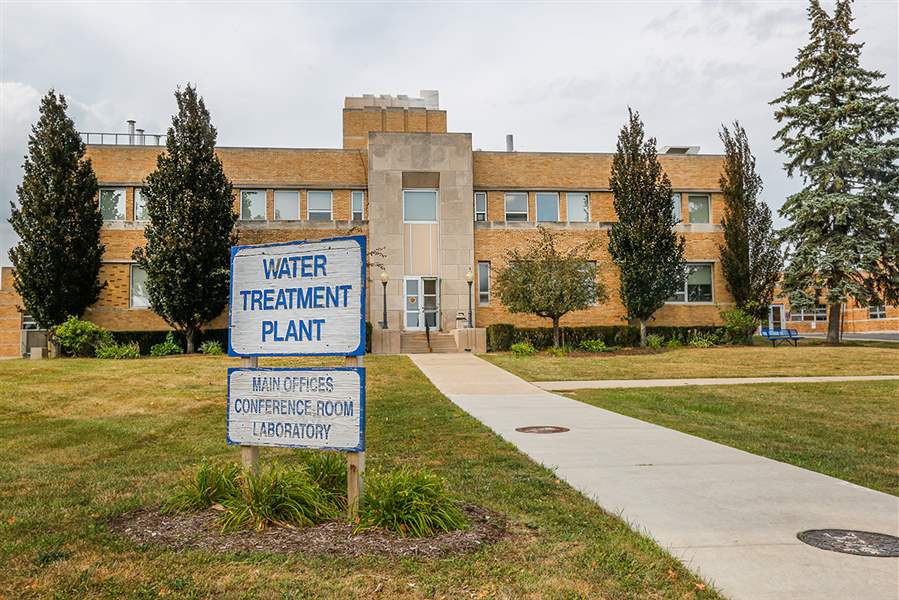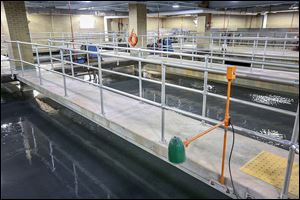
EPA takeover of Toledo water plant was being considered
State director cites slow response to water problems
8/10/2014
City engineers maintain there are no direct cause-and-effect links between the condition of the Collins Water Treatment Plant in East Toledo and the spike in toxins from algae..
THE BLADE/JETTA FRASER
Buy This Image

City engineers maintain there are no direct cause-and-effect links between the condition of the Collins Water Treatment Plant in East Toledo and the spike in toxins from algae..
Less than six months into the job, Ohio Environmental Protection Agency Director Craig Butler grew so weary of Toledo’s mule-like response to long-documented problems at its 73-year-old Collins Park Water Treatment Plant that he entertained the very drastic — and politically explosive — idea of trying to wrest control of it away from the city.
In an interview with The Blade, Mr. Butler said he recognizes Ohio has great respect for home rule and that the state makes every effort to keep local governments in charge of their own infrastructure.
“Us stepping across that boundary and taking control of that facility is something we try hard not to do,” Mr. Butler said. “But it is our obligation to hold their feet to the fire. We obviously have very strong concerns about the operability and the long-term capability of that plant. If we ever thought it would have jeopardized public health, we would have had that conversation.”
RELATED: Local firm keeps an eye on Lake Erie from high above
RELATED: Be better prepared for the next crisis
COMMENTARY: Can we build a green culture?
TOLEDO MAGAZINE: Life, water flowed on during crisis
Those strong concerns were evident in internal Ohio EPA correspondences obtained by The Blade that show some agency staff believed Toledo officials were at times not truthful, and that an engineering firm that works with the city raised red flags about the condition of the water system.
According to Chris Abbruzzese, the Ohio EPA’s deputy director for communications, the possibility of a state takeover of the plant was on the table.
“We were certainly seeing some things that were very disturbing and the situation was probably as close to the precipice of Ohio EPA having to come in as it’s been in any situation statewide in many years,” Mr. Abbruzzese wrote in an email to the newspaper.
Mr. Abbruzzese said the agency was “frustrated by the delays and had to elevate the tenor of discussion to get their attention.”
“We think we have it now, however, and they’re engaged the way they need to be,” he said.
The situation’s not new.
Mr. Butler, the Ohio EPA director since February, said he has seen a pattern of sluggishness throughout much of his 22 years as an Ohio EPA employee.
Like many things, it boiled down to a lack of money.
Band-Aid approach
Toledo adopted a fix-it-as-you-go mentality — a Band-Aid approach — instead of stepping back and seeing the big picture of spinning its wheels with near-constant maintenance of an aging facility and never really catching up.
“They have just developed a culture of running that plant at the razor’s edge,” Mr. Butler said. “They have an elevated sense of risk tolerance, because they’re fixing it all of the time. I don’t think they saw an elevated sense of urgency.”
Toledo Mayor D. Michael Collins and the city’s public utilities director, Ed Moore, don’t see it that way.
They see last weekend’s high spike of toxic algae that breached the treatment system as a symptom of foot-dragging on key environmental protections at all levels of government.
The bottom line, they said, is everyone needs to work harder to make western Lake Erie healthier.
“I was never in denial. I went out to that plant as a District 2 councilman in 2012 and said this plant has to be fixed,” Mr. Collins said.
Those two and others said they are moving forward with a $300 million upgrade that is to include a new unit capable of producing another 40 million gallons of water a day by 2019.
At the same time, they will entertain thoughts of relocating the water intake.
They also said they may gauge the council’s interest in a new plant, estimated to cost more than $1 billion.

The city is moving forward with a $300 million upgrade that is to include a new unit capable of producing another 40 million gallons of water a day by 2019.
“What I plan to do in the next few weeks is to come to some consensus what our vision is and what their expectations are,” Mr. Moore said.
But their immediate focus is on the new unit that will expand current capacity of 120 million gallons a day. The plan is to keep capacity at its current level and overhaul each of the other three units, one at a time.
Although they agree more adaptation may be necessary, city officials said the Ohio EPA and others cannot lose sight of the fact that Lake Erie is fouled by pollution.
“The algal bloom is what caused the issue,” Mr. Moore said. “The plant is producing safe water.”
City engineers maintain there are no direct cause-effect linkages between the plant’s condition and what happened during the first weekend in August, when 500,000 metro Toledo residents went scurrying for bottled water after being told a spike of toxic algae made their tap water undrinkable for three days.
But signs of neglect have been around for several administrations, punctuated by the revelation a couple of years ago that the plant’s roof was about to collapse on the treatment process.
Toledo’s City Council — reluctant to raise water rates for years — finally did so in 2013 to finance a new roof and the $300 million in improvements, the highlight of which will be a new unit and a finishing system that will make the overall plant more effective at combating algae.

The success of it depends on whether the Ohio EPA and other state regulators have the tenacity to toughen rules on sources of pollution sources feeding the algae, they said.
Long before last weekend, though, state records painted a picture of Toledo struggling to keep up with — even concealing — the aging system’s need for virtual nonstop repairs, with the Ohio EPA getting increasingly frustrated.
Withholding information
An internal Ohio EPA email on July 14 to several agency officials, including Mike Baker, chief of the Ohio EPA’s drinking water and ground waters division, stated that some agency officials believed the city was lying or withholding information about a 9-mile raw water main and manholes in the vicinity of the hazardous waste landfill operated by Envirosafe Services of Ohio Inc.
“Looks like the city didn’t tell us the truth about back up for operating cone valves and also regarding their lack of ability to operate the valves along their 9-mile raw water main,” the email, written by Judy Stottsberry, a specialist in surface water treatment, stated. “[I] have concerns for manholes in Envirosafe area based on the observations that water is leaking into the manholes since the seals were made where the pipe enters the manhole are not watertight.”
That same email begins with Ms. Stottsberry relaying concerns about issues with the city’s low-service pump station from SSOE, a Toledo-based engineering firm that has a long association with the city.
“Based on the review, it appears we will be struggling with the city to make absolutely critical changes,” Ms. Stottsberry wrote. “SSOE indicates that parts are way beyond useful life and critical to the process, yet they don’t go as far to say that these parts are an immediate need.”
The email said SSOE found 14 critical shutoff valves at the low-service pump station of such “suspect condition that they recommend an emergency contingency plan.”
Ms. Stottsberry’s correspondence said it appears SSOE was “uncomfortable with what they were able to recommend and made plenty of statements of how critical things were to apparently protect themselves.”
She wrote how it appears SSOE “intentionally left their own opinion out regarding what needs done” and instead carefully worded items as what the city wants.
Messages left for Tony Damon, SSOE president and chief executive officer, and a media spokesman were not returned.
Past and current Ohio EPA officials said Toledo has frustrated the agency with its sluggish pace for a long time, not recognizing what the regulator sees as priority fixes.
The Collins administration failed to pick up the agency’s signals to move faster, they said.
Shortly after taking office, Mr. Collins was told in a Jan. 30 letter by Mike Baker, Ohio EPA chief of drinking and ground waters, that Toledo “faces significant challenges completing a large number of critical infrastructure projects to ensure a reliable and safe source of drinking water.”
That was followed by a March 31 letter from Mr. Baker to Robert Reinbolt, the mayor’s chief of staff, and the city’s former public utilities director, Robin Whitney, which stated the Collins Park Water Treatment Plant “is vulnerable to potential failures that could severely impact the city’s ability to provide adequate quantities of safe water to the community.”
The language continued to get stronger.
“We emphasized the need to accelerate your purchasing process and complete these projects with the same urgency that would be necessitated were a failure to actually occur,” the letter said, recapping discussions from a meeting back then.
The paper trail suggests tensions continued to grow until hitting a crescendo with Mr. Butler’s now-widely circulated letter of June 9, in which he reiterated Mr. Baker’s earlier comment about the treatment plant being “vulnerable to potential failures.”
“I cannot underscore boldly enough the precarious condition of Toledo’s drinking water system and the imminent vulnerability to failure,” Mr. Butler wrote.
To former Ohio EPA Director Chris Jones, that trio of letters is the latest in which Toledo has not grasped the state regulator’s sense of urgency.
“For a regulator to put that kind of language in a letter, it’s very clear they’re very frustrated with the lack of action,” Mr. Jones said. “It appeared to me in a fairly short period of time they were sending a very clear message to Toledo that ‘You’ve got to do something about this.’ ”
Funding issues
All communities struggle to to fund water, road, sewer, and bridge projects, even with federal low-interest loans channeled through state programs.
Delays with high-priced infrastructure work “just naturally create tension,” Mr. Jones said.
“It’s pretty clear this is not one or two missed deadlines,” Mr. Jones said. “There’s pretty significant work that wasn’t getting done. It reached a crescendo.”
He said Mr. Collins should have picked up on the significance of an agency director directly contacting him, especially with such sharp words.
“A letter from the director to the mayor — that’s a pretty dramatic step,” Mr. Jones said. “Those should send a pretty strong signal.”
The Ohio EPA believes Toledo should have told its citizens more about the backlog of improvements it has to make at the Collins Park Water Treatment Plant.
But the agency had little to say when asked why it didn’t make that information known itself before.
Mr. Abbruzzese said the city needs to understand the regulator was losing patience, knowing the plant can’t last forever.
“Ohio has a strong policy of home rule and localities are afforded great deference to manage these types of resources, so the bar is high but it’s done if it needs to be done, especially when it comes to notification of the public,” he said. “If communities don’t make needed notifications when warranted, Ohio EPA can make them, but in this case the needed advisories went out when needed so it wasn’t necessary.”
Contact Tom Henry at: thenry@theblade.com or 419-724-6079.